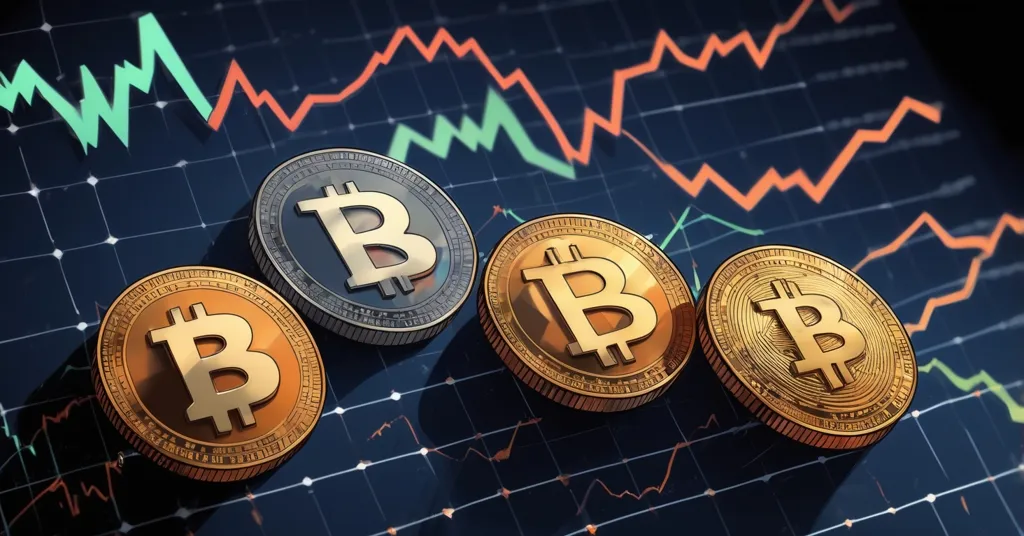Crypto Price Predictions for September 30: XRP, Aster, and Cardano Trends Analyzed

Crypto Price Predictions for September 30: XRP, Aster, Cardano Analysis and Trends
As the crypto market stumbles through a shaky recovery on September 30, the spotlight falls on XRP, Aster, and Cardano—three tokens grappling with short-term losses but carrying hefty promises of long-term gains. Are these altcoins the next big winners, or just another round of speculative fever? Let’s cut through the noise and dig into the data, the hype, and the hard realities.
- XRP ($XRP): Down 1% in the last 24 hours but boasting a 340% yearly surge, with ETF anticipation driving bullish sentiment.
- Aster ($ASTER): A fresh DeFi token up 1,700% from its lows, despite a brutal 25.5% correction from its recent peak.
- Cardano ($ADA): Slipping 9.5% in two weeks, yet poised for a rebound with a Grayscale ETF approval looking near-certain.
Market Context: A Fragile Recovery with High Stakes
The broader cryptocurrency space is clawing its way back from a rough stretch, with investor sentiment slowly warming up as of late September. Bitcoin, the unchallenged benchmark for altcoin price trends, continues to set the tone—its stability or swings often dictate whether altcoins like XRP or Cardano sink or swim. Beyond BTC’s shadow, whispers of institutional adoption through altcoin ETFs are stirring excitement, potentially paving the way for a bull run by the end of 2025. However, this isn’t a guaranteed win. Macro factors like interest rate shifts or sudden regulatory crackdowns could derail the momentum overnight. While Bitcoin remains the gold standard for decentralization and privacy—a core ethos we champion—these altcoins are carving out niches that BTC doesn’t directly address. Let’s explore if their potential matches the hype.
XRP: ETF Hopes vs. Regulatory Shadows
XRP, currently trading at $2.86 after a 1% dip in the past 24 hours, is a paradox of short-term stumbles and long-term strength. Over the past year, it’s skyrocketed 340%, inching close to its all-time high of $3.65. Some bold forecasts suggest it could shatter that ceiling by November or December. What’s behind this confidence? Ripple, the company steering XRP, is pushing hard for growth. They’re striking partnerships, acquiring firms, and expanding into new markets to cement XRP’s role in cross-border payments—a sector ripe for blockchain disruption due to its slow, costly traditional systems.
The real kicker, though, is the buzz around exchange-traded funds (ETFs). Up to ten XRP ETFs are reportedly in the pipeline, poised to unleash a wave of institutional demand. For those new to the term, ETFs are financial products that track an asset’s price and trade on traditional stock exchanges, making it easier for big-money players to invest without directly holding crypto. If approved, this could turbocharge XRP’s liquidity and legitimacy. But let’s pump the brakes—XRP is down 5% in the last two weeks, a reminder that volatility doesn’t care about fundamentals. Plus, regulatory risks loom large. Ripple’s ongoing battles with bodies like the U.S. Securities and Exchange Commission (SEC) over whether XRP is a security could stall progress. Remember the Bitcoin ETF saga? Initial approvals didn’t always translate to instant price moonshots. Hype is one thing; delivery is another.
Aster: Explosive DeFi Gains with a Side of Risk
Next up is Aster ($ASTER), the native token of a decentralized exchange (DEX) on the BNB Chain—a blockchain favored for its low fees and bustling DeFi ecosystem. Aster’s numbers are the kind that make even jaded traders blink twice: up 1,700% from its lowest price of $0.09971 (data courtesy of CoinGecko), though it’s now at $1.79 after a 7% drop in 24 hours and a staggering 25.5% fall from last week’s peak of $2.41. The Aster DEX itself isn’t a small fry, with $2.26 billion in total value locked (TVL). For newcomers, TVL is like a bank’s total deposits—it reflects how much crypto users have staked or locked in the platform, signaling trust and activity.
Analysts eyeing technical indicators like the Relative Strength Index (RSI)—a tool measuring if an asset is oversold or overbought—claim Aster is primed for a rebound, possibly hitting $2 soon and $3 by December. High momentum as a new top-100 token adds to the optimism. But let’s not drink the Kool-Aid just yet. A 25.5% crash in a week screams volatility, and new DeFi tokens often ride hype waves only to collapse when the buzz fades. Compared to giants like Uniswap or even BNB Chain’s own PancakeSwap, does Aster truly stand out with unique features, or is it just another clone? Historical flops like countless 2021 DeFi tokens remind us that early gains don’t guarantee longevity. Investors need to ask if this is a genuine contender or a classic pump-and-dump trap waiting to fleece the unwary. For more detailed insights on current trends for Aster and other tokens, check out this analysis of crypto price predictions for September 30.
Cardano: Scalability Star with ETF Potential
Cardano ($ADA) isn’t exactly lighting up the charts right now, sitting at $0.7878 after a 4.5% drop this week and a 9.5% slide over the past fortnight. Yet, the community around this layer-1 blockchain—built with a focus on scalability and sustainability—is buzzing with anticipation. A major driver is the near-certain approval of a Grayscale ETF, with Bloomberg analysts pegging its odds at 100%. Grayscale, a titan in crypto asset management, has a history of influencing markets with its funds. If this ETF gets the green light, institutional cash could flood in, potentially pushing ADA past $1 by October’s end and even to $3 by December, as some predict.
Cardano’s tech also deserves a nod. Its Ouroboros proof-of-stake mechanism—think of it as a greener, more efficient way to validate transactions compared to Bitcoin’s energy-hungry mining—positions it as a forward-thinking blockchain. Its ecosystem ranks in the top 20 for TVL, with steady development keeping it relevant. Still, there’s a flip side. Short-term price action is ugly, and banking on ETF approvals is risky until they’re official. Past cycles show Cardano often lags in bull runs compared to flashier altcoins, and regulatory delays could dampen the ETF spark. While blockchain ETFs could boost altcoin investments, they don’t guarantee a straight path up. Is Cardano’s slow-and-steady approach a strength, or will it get left behind in a market obsessed with quick gains?
PEPENODE: A Wildcard with Warning Signs
Stepping away from established names, we have PEPENODE ($PEPENODE), an ERC-20 presale token that’s raised over $1.5 million. Billed as the first “mine-to-earn” token, it lets users build virtual mining rigs to earn rewards in meme coins like Pepe and, yes, FARTCOIN. Picture it as a video game where you construct a digital factory to churn out crypto rewards instead of points. Priced at $0.0010788 in presale (set to rise soon), it’s marketed as a speculative high-growth bet. The concept is quirky and intriguing, tapping into gamified staking trends in DeFi.
But let’s be brutally honest: presale tokens are a high-risk gamble. For every breakout success, there are dozens of rug pulls or abandoned projects. The $1.5 million raised shows some interest, but it’s a drop in the bucket compared to the scams that have fleeced billions over the years. Without a proven track record or transparent team data, PEPENODE is a shot in the dark. If you’re tempted, keep it to pocket change you’re willing to lose. DeFi token risks are real, and newcomers especially need to prioritize due diligence over FOMO.
Bitcoin’s Shadow and the Bigger Picture
While altcoins like XRP, Aster, and Cardano push unique innovations, Bitcoin remains the ultimate yardstick for decentralization—a reminder that not every new token needs to dethrone the king. BTC’s price trends often ripple through the market, and its upcoming halving or broader adoption could lift all boats or sink the weaker ones. Meanwhile, the prospect of altcoin ETFs signals a shift toward mainstream acceptance, potentially drawing massive institutional capital into the space by 2025. This could reshape the debate on decentralization—will more traditional money strengthen blockchain’s disruptive power, or dilute its rebel spirit with corporate oversight?
Technical tools like RSI or MACD (Moving Average Convergence Divergence, which tracks price momentum shifts) are often cited in these price forecasts, but they’re not crystal balls. Crypto markets are driven as much by emotion, news, and random tweets as by cold data. Short-term dips in XRP, Aster, and Cardano might be buying opportunities for some, but they’re also stark warnings of volatility. Long-term, the fight for privacy, freedom, and financial disruption via blockchain tech remains a cause worth backing. Just don’t expect a smooth ride.
Key Takeaways and Questions
- What’s fueling the bullish outlook for XRP?
Ripple’s relentless push through partnerships, acquisitions, and market expansion, paired with up to ten potential ETF launches, underpins forecasts of XRP surpassing its $3.65 all-time high by year-end. - Can Aster sustain its DeFi momentum after a sharp correction?
A 1,700% rise from its low and $2.26 billion in TVL signal promise for Aster, but a 25.5% drop from its peak highlights extreme volatility—investors must weigh if it’s a lasting player or a fleeting hype. - How might a Cardano ETF reshape its future?
With a reported 100% approval likelihood from Bloomberg analysts, a Grayscale ETF could draw institutional funds, potentially lifting ADA past $1 soon and bolstering its scalability-focused blockchain. - Is PEPENODE a worthwhile presale investment?
Its “mine-to-earn” model and $1.5 million raised are eye-catching, but presales are riddled with scams and failures—extreme caution is essential, especially for newer investors. - Could altcoin ETFs trigger a crypto bull run?
Approvals for XRP and Cardano ETFs might attract significant capital by 2025, enhancing liquidity and adoption, though regulatory hiccups or market sentiment shifts could temper the impact. - How does Bitcoin influence these altcoin predictions?
Bitcoin’s market dominance often drives altcoin trends—its stability or volatility can amplify gains or losses for XRP, Aster, and Cardano, making BTC a critical factor in any forecast.
Let’s be clear: the promise of blockchain to upend outdated financial systems is real, and tokens like XRP and Cardano are part of that fight. But so is crypto’s knack for crushing the unprepared. Dig deeper, question every prediction, and guard your stack. This space is a revolution, but it’s also a gauntlet—navigate it with eyes wide open.



